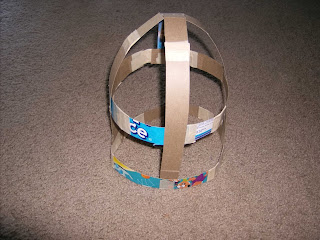I figured the only way to get rid of these cracks is to literally cut them out down to the source. I used my exacto knife to cut along both sides of every crack. If your helmet is still slightly bendable even at this stage, go ahead and play with it a little bit because I assume the cracks will make themselves known down the road if you don't fix them now. While I wish I would've fixed this at an earlier stage of construction, I know it will be much easier to fix this now than to do so later.
Now to make sure that I get rid of these cracks down to their source, I enlisted the help of a Dremel cutting tool. I found this in the hardware section at Wal-Mart, it's the Dremel 7300 that comes with 5 accessories (one of which I used for the following step). It's a handly tool for this project for under $25. I also picked up a little pack of cutting wheel accessories (around $5) which I plan to use for reshaping the visor and mouth hole openings later.
\I used the grinding accessory from inside the box and I scoured each of the areas I cut out to make these cracks disappear once and for all. Just a friendly reminder, read through the directions on this tool as you could be injured if it is used carelessly. Even though it's small, it's still a spinning power tool with sharp accessories.
After I fully grinded each crack out sufficiently with the Dremel tool, I used little dabs of Dry-Dex to coat the rough patches where I had sanded back down to the Celluclay layer. I am constantly reminded that I should have focused on perfecting the helmet shape earlier, but what can you do? First time helmets are undoubtedly trial-and-error.
After the Dry-Dex dried, I lightly sanded with the most soft grained sandpaper I had. I was careful not to sand to hard. The idea was to maintain the white color, if black started to appear I would have sanded too far and would have had to coat it again. There are a couple of lumpy spots on the left-rear side of the helmet that I will have to coat one last time with Dry-Dex after I fill in the cracks.
The reason I am doing parts of the Dry-Dex/sand step is because there are different levels of sanding necessary. I didn't want to accidently sand too hard in one spot mistaking it for a crack-fill when it was actually a rough patch. I really have made this more difficult than I needed to! Here is how it looked with the cracks filled before and after sanding.
[Picture 1 and 2 to be uploaded]
After I reshaped the lumpy spots with the Dry-Dex and sanded, I made sure to blow all of the sanding dust off of it and sprayed one last coat of primer. Once it dries, we will see if the damage control has worked. The next post will involve reshaping the visor and mouth hole and any other cuts I need to make in reshaping the bottom of the helmet.

































